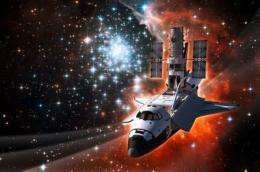Servicing Mission 4 -- the fifth and final visit to Hubble

(PhysOrg.com) -- The combination of Hubble's powerful suite of instruments and its position far above the effects of Earth's atmosphere has consistently produced outstanding scientific results for nineteen years. This success is due to both the robust initial design of the spacecraft and the remarkable series of servicing missions that have kept the complex operating platform functioning and up to date.
Astronauts from NASA and ESA visited Hubble in 1993, 1997, 1999 and 2002, carrying out a whole series of repairs and upgrades on each occasion. During the upcoming Servicing Mission 4 (SM4) astronauts will make five spacewalks to complete one last set of improvements that will mean that every major component on the spacecraft, apart from the mirrors, will have undergone at least one upgrade since launch.
The primary objective of the mission is to deliver two new instruments. The Cosmic Origins Spectrograph (COS) will sit in the slot currently occupied by the now redundant COSTAR package, and the enhanced Wide Field Camera 3 (WFC3) will replace the current WFPC2. Both instruments use advanced technology to improve Hubble's potential for discovery dramatically and enable observations of the faint light from the youngest stars and galaxies in the Universe.
The Cosmic Origins Spectrograph will primarily study light from faint, distant quasars that has passed through intergalactic gas clouds, galaxies and voids on a trajectory through the history of the Universe. By splitting the quasar light into different wavelengths (or colours) and studying how much or how little of each wavelength is absorbed astronomers can determine the chemical composition and exact location of matter along the way, providing information on both the large-scale structure of the Universe and the evolution of its chemical composition.
WFC3 is a state-of-the-art imaging platform. It is the first single instrument on Hubble to be able to image across the infrared, visible and ultraviolet wavebands. As a result, astronomers will have a unique opportunity to observe the different stellar populations within distant galaxies, study objects at high redshifts and to look for water and ice on bodies within the Solar System.
"Following this servicing mission, Hubble will become a considerably more powerful observatory than ever before and will be superbly equipped to continue its pivotal role in observational astrophysics well into the next decade," said Bob Fosbury, Head of ESA's Space Telescope — European Coordinating Facility (ST-ECF).
Replacing instruments is complicated enough, but there is an additional twist: two others need fixing — the Advanced Camera for Surveys (ACS) and the Space Telescope Imaging Spectrograph (STIS). This attempt to conduct in-orbit repairs is unprecedented, and to meet this challenge engineers have developed new tools and procedures specifically for this mission.
Hubble itself also requires some care and attention. The batteries, for example, need updating, as Hubble is still flying with the originals and, after over 19 years of continuous use, they are starting to degrade. Other fixes to the spacecraft, such as replacing the fine guidance sensor and gyroscope units, will ensure that Hubble remains operational for many years to come.
ESA contributes a 15 percent share to Hubble's development and in return European astronomers receive a guaranteed 15 percent share of observing time. In practice the high quality of proposals from scientists in Europe has kept their average share above 20 percent. ESA's contributions to Hubble have been vital. At the outset of the mission, ESA provided two sets of solar arrays and the Faint Object Camera (FOC) which preceded the current Advanced Camera for Surveys (ACS). FOC, decommissioned in 2002, was an extremely powerful and sensitive optical and ultraviolet camera that allowed astronomers to distinguish faint points of light as individual objects.
ESA also supplied the two Solar Array Drive Mechanisms (SADM), the Solar Array Drive Electronics (SADE) and the Drive Control Electronics as part of its initial contribution to the development of the telescope. Solar-powered spacecraft such as Hubble rely on accurate pointing of their solar arrays to achieve maximum power. The manipulation of the solar arrays is also critical during spacecraft capture and space walks so that astronauts can work unhindered. For SM4, ESA's involvement with this mission is largely in a support capacity at the mission control facilities at the Goddard Space Flight Center, where ESA engineers will help monitor the solar array performance throughout mission activities.
Late last year Hubble broke one of the longest standing space records. On 28 December 2008, Hubble clocked up its 6823rd day in orbit and overtook the record for continuous orbital observations held by the ESA/NASA/UK International Ultraviolet Explorer, a mission that ceased operations in 1996. During this impressive run, Hubble has carried out many observations, both close to home in the Solar System and out to the furthest extremes of the Universe.
In conjunction with this release, a special episode of the popular Hubblecast (video podcast) has been produced. Dr. J. will take a closer look at the future science from a refurbished Hubble and at some of the challenges facing the astronauts.
• Join PhysOrg.com on Facebook!
• Follow PhysOrg.com on Twitter!
Source: European Space Agency (news : web)


















